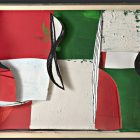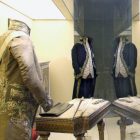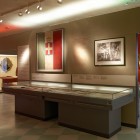Tricolour Flag Museum
Museo del Tricolore
The Italian national flag was first adopted in Reggio Emilia on 7 January 1797. On that day, representatives of the cities of Reggio Emilia, Modena, Bologna and Ferrara proclaimed the green, white, and red Tricolour to be the banner of the Cispadane Republic. The historic event took place in the Municipal Palace, specifically in a large hall built between 1772 and 1787, according to a design by Lodovico Bolognini, to host the general archive of the Estense Duchy. The hall was subsequently named Congress Hall and then Tricolore Hall, and is now the home of the City Council. The Museum of the Tricolour Flag was opened in 2004 to document the historical and political context in which the flag was created.
-
Read more
The museum display extends along two parallel lines: the history of the Italian flag from its origins to the achievement of the country’s independence and unity, and the history of political events in Reggio Emilia from the birth of the Reggiana Republic to the contribution made by Reggio natives to the battle for national redemption.
The birth of the flag and the history of political events in Reggio Emilia from 1796 to the beginning of the Restoration are presented in the Napoleonic hall.
After the Reggiana Republic was proclaimed on 26 August 1796, the Congress of the Cispadane Republic – meeting in the Tricolore Hall – approved a motion by Giuseppe Compagnoni to turn “the Cispadane banner or flag in the three colours of green, white and red into a universal symbol”. The result was the Tricolour, a flag of a sovereign state, which would soon become a symbol of independence and national unity. The colours on the Cispadane banner are arranged in three horizontal stripes, with red at the top, white in the middle and green at the bottom. At the centre, a quiver with four arrows symbolised the union of the four peoples that made up the Republic, and the initials of the “Repubblica Cispadana” were placed at the sides. On 9 July 1797, the Cisalpine Republic was created with the merger of the Transpadane and Cispadane Republics. “The flag of the Cisalpine Nation is formed by three bands that are parallel to the flagpole, with the green band next to the pole, the next band being white, and the third band being red”. In the spring of 1799, the victorious advance of the Austro-Russian armies forced French troops to retreat. After Napoleon’s victory at Marengo and the re-establishment of the Cisalpine Republic, the peace of Lunéville between France and Germany was celebrated also in Reggio Emilia with a great patriotic festival that featured a monumental architectural structure built in Piazza Grande as the scenographic backdrop.
In the Italian Republic which was founded on 26 January 1802, and in the subsequent Kingdom of Italy, some of the most important government positions were held by Reggio Emilia natives. Worth a special mention are: Giovanni Paradisi, Senator and President of the Senate; Antonio Veneri, Treasury Minister and President of the Senate; scientist Giambattista Venturi, a diplomat assigned to Switzerland; and General Carlo Zucchi, who was promoted to Inspector General of the entire infantry of the Kingdom after taking part in all the Napoleonic wars.
Displayed in the risorgimental hall are materials that extend from the Restoration to the completion of national unity, up to 1897, the year of the first Centenary of the Tricolour flag, which culminated with a famous speech by Giosuè Carducci.
With the Restoration, the national flag was banned. The Tricolour was not to be raised again until the 1831 insurrection in the Duchies and in the Papal State. Following the repression in 1831, which signalled the failure of the conspiratorial methods of the Carbonari, Giuseppe Mazzini adopted the white, red and green Tricolour for his Young Italy.
In the first half of the 1840s, a new chapter in Italy’s political history began. Pius X, the new Pope – together with Carlo Alberto – was hailed as the liberator of Italy, and his face was associated more and more often with the Tricolour on flags and patriotic bandanas.
In the revolutionary season of 1848-49, tricolour flags, cockades, scarves and bandanas resurfaced in many areas of Italy as symbols of freedom from foreign oppression. Tricolour flags again flew in many Italian cities in 1859 and 1860, and they accompanied Garibaldi’s Expedition of the Thousand. On 25 March 1860, a royal decree established the characteristics of the new flag of the Sardinian Army: the Tricolour, with the addition of a crown above the coat-of-arms of the House of Savoy. This model was confirmed also after the Kingdom of Italy was proclaimed on 17 March 1861, and it also appeared in subsequent events that were fundamental to Italian history: the Third War of Independence (1866) and the Capture of Porta Pia (1870), with the resulting displacement of the capital from Florence to Rome. The flag, in virtually unchanged form, remained in force with these characteristics until the referendum of 1946, which led to the birth of the Republic of Italy. On 7 January 1947, demonstrations honouring the 150th anniversary of the flag took place in Reggio Emilia, with President Enrico de Nicola attending. On 7 January 2011, celebrations for the 150th anniversary of Italian Unity began in the “City of the Tricolour” and were attended by President Giorgio Napolitano.
-

Tricolour Inspiration
The genesis of “Ninety artists for a Flag” Tommaso Cascella (Roma 1951), Waiting for the…
-

The Tricolour Flag (Napoleonic room)
The birth of the flag and the history of political events in Reggio Emilia from…
-

Italia Tricolore (The Risogimental Hall)
Tricolour Flag Museum Italia Tricolore (The Risogimental Hall) In the Italia Tricolour Hall are displayed…
address
p.zza Casotti, 1
42121 Reggio Emilia
Tel. 0522/456033


